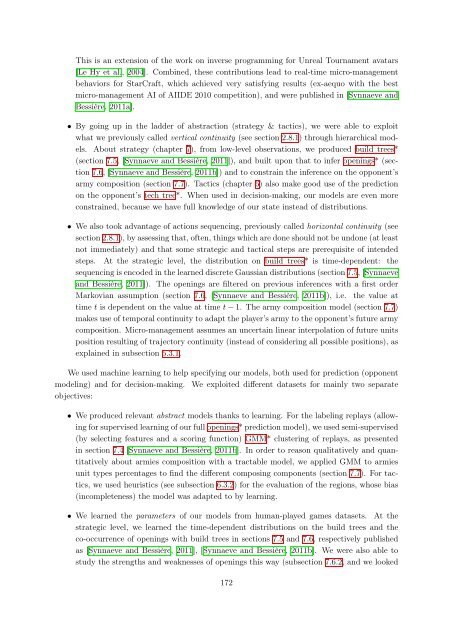Bayesian Programming and Learning for Multi-Player Video Games ...
Bayesian Programming and Learning for Multi-Player Video Games ...
Bayesian Programming and Learning for Multi-Player Video Games ...
You also want an ePaper? Increase the reach of your titles
YUMPU automatically turns print PDFs into web optimized ePapers that Google loves.
This is an extension of the work on inverse programming <strong>for</strong> Unreal Tournament avatars<br />
[Le Hy et al., 2004]. Combined, these contributions lead to real-time micro-management<br />
behaviors <strong>for</strong> StarCraft, which achieved very satisfying results (ex-aequo with the best<br />
micro-management AI of AIIDE 2010 competition), <strong>and</strong> were published in [Synnaeve <strong>and</strong><br />
Bessière, 2011a].<br />
• By going up in the ladder of abstraction (strategy & tactics), we were able to exploit<br />
what we previously called vertical continuity (see section 2.8.1) through hierarchical models.<br />
About strategy (chapter 7), from low-level observations, we produced build trees*<br />
(section 7.5, [Synnaeve <strong>and</strong> Bessière, 2011]), <strong>and</strong> built upon that to infer openings* (section<br />
7.6, [Synnaeve <strong>and</strong> Bessière, 2011b]) <strong>and</strong> to constrain the inference on the opponent’s<br />
army composition (section 7.7). Tactics (chapter 6) also make good use of the prediction<br />
on the opponent’s tech tree*. When used in decision-making, our models are even more<br />
constrained, because we have full knowledge of our state instead of distributions.<br />
• We also took advantage of actions sequencing, previously called horizontal continuity (see<br />
section 2.8.1), by assessing that, often, things which are done should not be undone (at least<br />
not immediately) <strong>and</strong> that some strategic <strong>and</strong> tactical steps are prerequisite of intended<br />
steps. At the strategic level, the distribution on build trees* is time-dependent: the<br />
sequencing is encoded in the learned discrete Gaussian distributions (section 7.5, [Synnaeve<br />
<strong>and</strong> Bessière, 2011]). The openings are filtered on previous inferences with a first order<br />
Markovian assumption (section 7.6, [Synnaeve <strong>and</strong> Bessière, 2011b]), i.e. the value at<br />
time t is dependent on the value at time t − 1. The army composition model (section 7.7)<br />
makes use of temporal continuity to adapt the player’s army to the opponent’s future army<br />
composition. Micro-management assumes an uncertain linear interpolation of future units<br />
position resulting of trajectory continuity (instead of considering all possible positions), as<br />
explained in subsection 5.3.1.<br />
We used machine learning to help specifying our models, both used <strong>for</strong> prediction (opponent<br />
modeling) <strong>and</strong> <strong>for</strong> decision-making. We exploited different datasets <strong>for</strong> mainly two separate<br />
objectives:<br />
• We produced relevant abstract models thanks to learning. For the labeling replays (allowing<br />
<strong>for</strong> supervised learning of our full openings* prediction model), we used semi-supervised<br />
(by selecting features <strong>and</strong> a scoring function) GMM* clustering of replays, as presented<br />
in section 7.4 [Synnaeve <strong>and</strong> Bessière, 2011b]. In order to reason qualitatively <strong>and</strong> quantitatively<br />
about armies composition with a tractable model, we applied GMM to armies<br />
unit types percentages to find the different composing components (section 7.7). For tactics,<br />
we used heuristics (see subsection 6.3.2) <strong>for</strong> the evaluation of the regions, whose bias<br />
(incompleteness) the model was adapted to by learning.<br />
• We learned the parameters of our models from human-played games datasets. At the<br />
strategic level, we learned the time-dependent distributions on the build trees <strong>and</strong> the<br />
co-occurrence of openings with build trees in sections 7.5 <strong>and</strong> 7.6, respectively published<br />
as [Synnaeve <strong>and</strong> Bessière, 2011], [Synnaeve <strong>and</strong> Bessière, 2011b]. We were also able to<br />
study the strengths <strong>and</strong> weaknesses of openings this way (subsection 7.6.2, <strong>and</strong> we looked<br />
172


